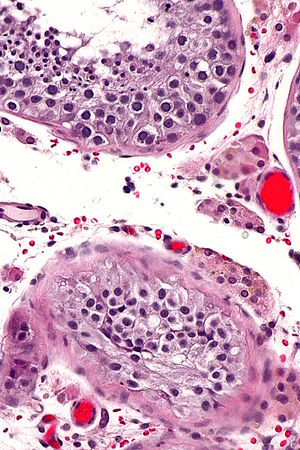Difference between revisions of "Testicular atrophy"
(touch) |
(to GCNIS) |
||
| (3 intermediate revisions by the same user not shown) | |||
| Line 7: | Line 7: | ||
| Micro = thickening of seminiferous tubule basement membrane, decreased sperm/no sperm present, +/-intertubular fibrosis | | Micro = thickening of seminiferous tubule basement membrane, decreased sperm/no sperm present, +/-intertubular fibrosis | ||
| Subtypes = | | Subtypes = | ||
| LMDDx = | | LMDDx = [[sertoli cell nodule]], [[testicular scar]], [[germ cell neoplasia in situ]], [[seminoma]] - esp. intertubular | ||
| Stains = | | Stains = | ||
| IHC = | | IHC = | ||
| Line 50: | Line 50: | ||
*Sertoli cells may have a cytoplasm with eosinophilic granules (lysosomes). This is a nonspecific finding described in several contexts.<ref name=pmid1672120>{{Cite journal | last1 = Nistal | first1 = M. | last2 = Garcia-Rodeja | first2 = E. | last3 = Paniagua | first3 = R. | title = Granular transformation of Sertoli cells in testicular disorders. | journal = Hum Pathol | volume = 22 | issue = 2 | pages = 131-7 | month = Feb | year = 1991 | doi = | PMID = 1672120 }}</ref> | *Sertoli cells may have a cytoplasm with eosinophilic granules (lysosomes). This is a nonspecific finding described in several contexts.<ref name=pmid1672120>{{Cite journal | last1 = Nistal | first1 = M. | last2 = Garcia-Rodeja | first2 = E. | last3 = Paniagua | first3 = R. | title = Granular transformation of Sertoli cells in testicular disorders. | journal = Hum Pathol | volume = 22 | issue = 2 | pages = 131-7 | month = Feb | year = 1991 | doi = | PMID = 1672120 }}</ref> | ||
DDx: | |||
*[[Sertoli cell nodule]]. | *[[Sertoli cell nodule]]. | ||
*[[Testicular scar]]. | *[[Testicular scar]]. | ||
*[[ | *[[Germ cell neoplasia in situ]] (intratubular germ cell neoplasia). | ||
*[[Seminoma]]. | *[[Seminoma]] - especially where intertubular growth is predominant.<ref name=pmid15316315>{{Cite journal | last1 = Henley | first1 = JD. | last2 = Young | first2 = RH. | last3 = Wade | first3 = CL. | last4 = Ulbright | first4 = TM. | title = Seminomas with exclusive intertubular growth: a report of 12 clinically and grossly inconspicuous tumors. | journal = Am J Surg Pathol | volume = 28 | issue = 9 | pages = 1163-8 | month = Sep | year = 2004 | doi = | PMID = 15316315 }}</ref> | ||
===Images=== | ===Images=== | ||
| Line 70: | Line 70: | ||
TESTICLE, RIGHT, ORCHIECTOMY: | TESTICLE, RIGHT, ORCHIECTOMY: | ||
- ATROPHIC TESTICLE. | - ATROPHIC TESTICLE. | ||
- NEGATIVE FOR INTRATUBULAR GERM CELL NEOPLASIA. | - NEGATIVE FOR GERM CELL NEOPLASIA IN SITU (INTRATUBULAR GERM CELL NEOPLASIA). | ||
- NEGATIVE FOR MALIGNANCY. | - NEGATIVE FOR MALIGNANCY. | ||
</pre> | </pre> | ||
Latest revision as of 00:03, 16 March 2016
| Testicular atrophy | |
|---|---|
| Diagnosis in short | |
 Atrophic changes of the testis (bottom). H&E stain. | |
|
| |
| Synonyms | atrophic testis, atrophy of the testis |
|
| |
| LM | thickening of seminiferous tubule basement membrane, decreased sperm/no sperm present, +/-intertubular fibrosis |
| LM DDx | sertoli cell nodule, testicular scar, germ cell neoplasia in situ, seminoma - esp. intertubular |
| Site | testis |
|
| |
| Clinical history | +/-undescended testis (cryptorchidism) |
| Prevalence | not common |
| Prognosis | benign |
| Treatment | long standing cryptorchidism - removal |
Testicular atrophy is relatively common change seen in undescended testes. It is also known as atrophic testis and atrophy of the testis.
Cryptorchidism redirects here.
General
- Microscopic appearance identical to cryptorchidism (undescended testis).[1]
Gross
- Decreased size.[2]
Microscopic
Features:[1]
- Thickening of seminiferous tubule basement membrane.
- Intertubular fibrosis.
- Decreased sperm/no sperm present.
Notes:
- End-stage testicle - only has Sertoli cell within the seminiferous tubules.
- Sertoli cells may have a cytoplasm with eosinophilic granules (lysosomes). This is a nonspecific finding described in several contexts.[3]
DDx:
- Sertoli cell nodule.
- Testicular scar.
- Germ cell neoplasia in situ (intratubular germ cell neoplasia).
- Seminoma - especially where intertubular growth is predominant.[4]
Images
www:
Sign out
TESTICLE, RIGHT, ORCHIECTOMY: - ATROPHIC TESTICLE. - NEGATIVE FOR GERM CELL NEOPLASIA IN SITU (INTRATUBULAR GERM CELL NEOPLASIA). - NEGATIVE FOR MALIGNANCY.
Micro
The sections show seminiferous tubules surrounded by thick hyaline sleeves. In a large number of sections only Sertoli cells are found in the tubules.
In some sections poorly defined paucicellular tubular structures reminiscent of seminiferous tubules composed of hyaline material are present; these probably represent obsolete seminiferous tubules. Focally, fibrosis is seen without definite tumour outlines. There is no significant inflammation. The rete testis is identified.
Rare seminiferous tubules have spermatid within. The germ cells seen do not have appreciable nuclear atypia.
Small Leydig cell clusters are seen in some sections.
See also
- Testis.
- Pick's adenoma (Sertoli cell nodule).
References
- ↑ 1.0 1.1 Mitchell, Richard; Kumar, Vinay; Fausto, Nelson; Abbas, Abul K.; Aster, Jon (2011). Pocket Companion to Robbins & Cotran Pathologic Basis of Disease (8th ed.). Elsevier Saunders. pp. 506-7. ISBN 978-1416054542.
- ↑ Zvizdic Z, Milisic E, Halimic A, Zvizdic D, Zubovic SV (2014). "Testicular volume and testicular atrophy index as predictors of functionality of unilaterally cryptorchid testis". Med Arch 68 (2): 79–82. PMID 24937926.
- ↑ Nistal, M.; Garcia-Rodeja, E.; Paniagua, R. (Feb 1991). "Granular transformation of Sertoli cells in testicular disorders.". Hum Pathol 22 (2): 131-7. PMID 1672120.
- ↑ Henley, JD.; Young, RH.; Wade, CL.; Ulbright, TM. (Sep 2004). "Seminomas with exclusive intertubular growth: a report of 12 clinically and grossly inconspicuous tumors.". Am J Surg Pathol 28 (9): 1163-8. PMID 15316315.



